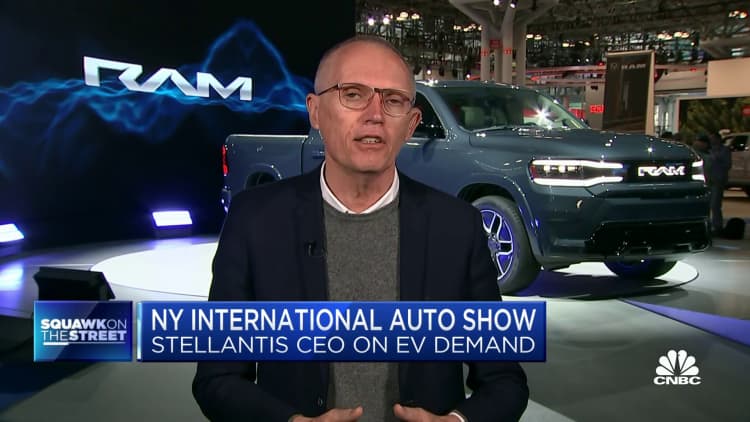A Tesla Model S electric car stops for recharging April 9, 2023 at a service station in Greenwich, Connecticut.
Thank you for reading this post, don't forget to subscribe!Robert Nickelsberg | Getty Images
There may be no better time to buy an electric vehicle than now.
Automakers are continuing to roll out a growing number of models that offer improved range and better performance.
That push is only being furthered by The White House, which just released the toughest tailpipe emissions rules in history and has set a goal that as much as two-thirds of all new vehicle sales be electric by 2032, and is putting heavy emphasis on a building a network of charging stations.
Prices of EVs are also starting to decline, with market leader Tesla already cutting prices multiple times this year, leading other manufacturers like Ford to follow suit.
The race to the $25,000 mass market EV is on.
Many potential buyers of an EV may look to take advantage of one of the many financial incentives available to potential EV buyers through federal, state and utility-run programs, such as the $7,500 federal tax credit. However, increasing standards for these rebates and savings are making it harder for buyers to qualify, though there are some workarounds.
Read more about electric vehicles from CNBC Pro
Beyond financial credits and rebates, many car shoppers don’t know they may also be able to get a better deal on a car loan associated with an electric vehicle. These so-called green auto loans aren’t necessarily well-advertised, so consumers need to do their homework.
There’s no difference between green auto loans and other car loans, other than that the borrower might be able to get a discount for purchasing an EV. “It’s just basically an auto loan with a lower rate, if lenders offer it,” said Edward Lyons, director of financial services for AAA Northeast Bank, which operates as a loan broker, working with several credit unions.
These loans can be used to purchase an environmentally-friendly car. Deals may be available for electric, hybrid or flexible fuel vehicles, and they aren’t tied to one manufacturer, Lyons said.
Always ask the lender what discounts may be available. Especially if it’s a hybrid, consumers don’t always realize the car could be eligible for a lower rate, but it could be, depending on the lender, Lyons said.
Consumers might expect to save 25 to 100 basis points compared with a rate being offered for regular vehicles, auto loan professionals say. The discount will vary by lender, so it pays to shop around, Lyons said.
The discounts could amount to quite a bit of money over the length of the loan. Borrowers may also be able to get a favorable rate loan that has a longer payoff term. A standard internal combustion car loan is set in 12-month increments from 24 months to 84 months, with 72 months typical. Borrowers typically won’t be offered more than 84 months, and that is usually in exchange for higher rates, said Ezra Peterson, senior director of insurance at Way.com, a platform that helps consumers purchase car insurance, refinance and with other auto-related services. By contrast, green auto loans could extend the repayment beyond the standard timeframe, at favorable rates, he said.
Borrowers might also be able to roll in the cost of a charging station with their vehicle financing, similar to green mortgages which allow homebuyers to include the cost of energy efficiency upgrades.
The loans aren’t necessarily well-advertised, so consumers will likely need to do some digging. “If you don’t know to ask or where to look you could end up paying thousands of dollars more over the life of the car,” Peterson said. Credit unions and banks may offer these loans, but credit unions tend to have better offers, Peterson said. Borrowers who aren’t already members of a credit union can do a Google search to find a local, or even national, credit union that offers green auto loans. Consumers may have to become a member or open a savings account to benefit from these deals, he said.
EV manufacturers may also offer loan discounts, but dealership finance departments might not tell potential buyers about them, so consumers have to know to ask, Peterson said.
Rates will vary by the size, length of the loan and the borrower’s credit score and other conditions, so borrowers should be sure they are comparing apples to apples. Lyons recommends getting at least three quotes for comparison purposes. To get a more general sense of what could be available for auto loan rates and terms, borrowers can first visit a marketplace like Bankrate.com.
“You have to do your homework and know what you’re getting into before you get there,” Lyons said.
Especially at the height of the pandemic when used car and new car values shot through the roof and there was a lot of desperation buying, people may have gotten a bad loan on an EV. It might make sense to investigate what’s out there in terms of refinancing, Peterson said. “The worst thing it costs you is maybe four or five phone calls,” he said.
There’s generally a small fee associated with transferring the vehicle’s title, but upfront fees to refinance are almost nothing, Peterson said. Typically, consumers won’t want to extend their term if they are being offered the same interest rate, but if a borrower is paying 12.9% and getting a new offer for 5%, extending the term a bit and accepting a significantly better rate could be advantageous, Peterson said.


